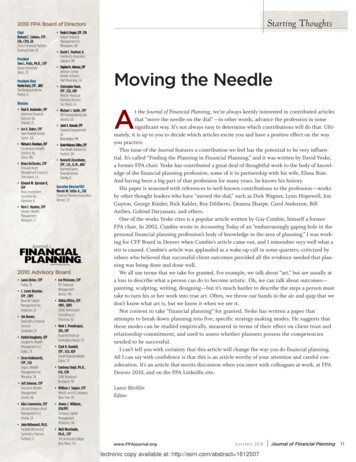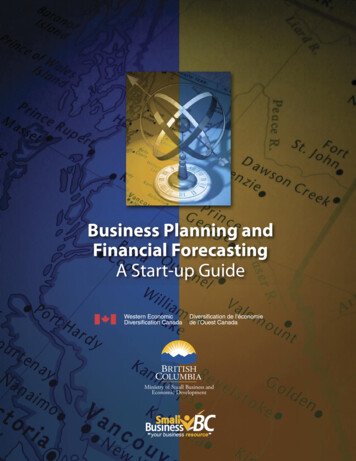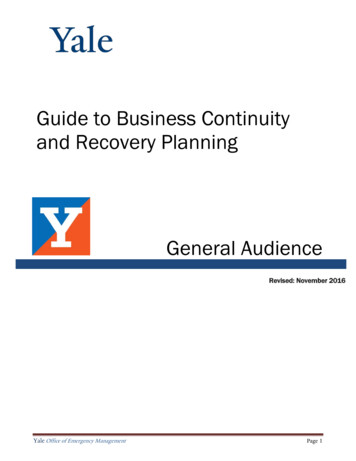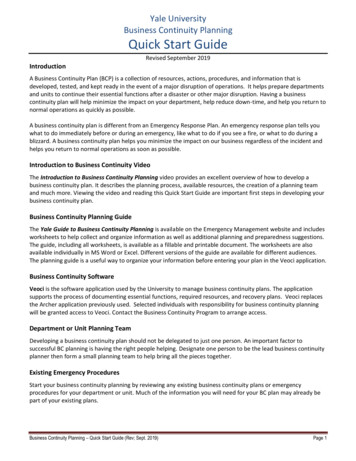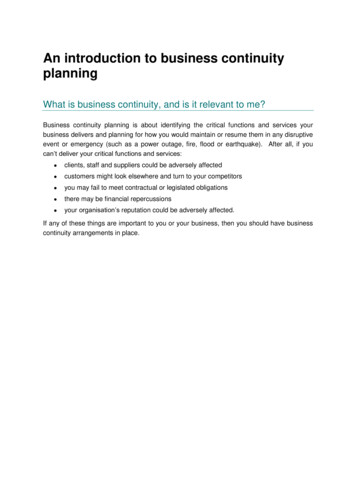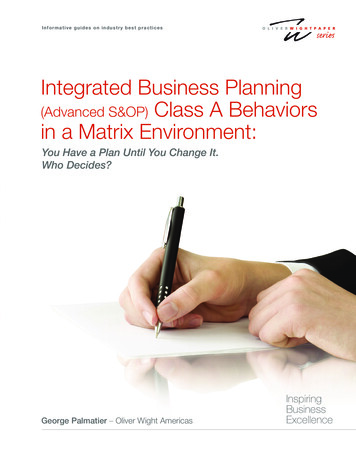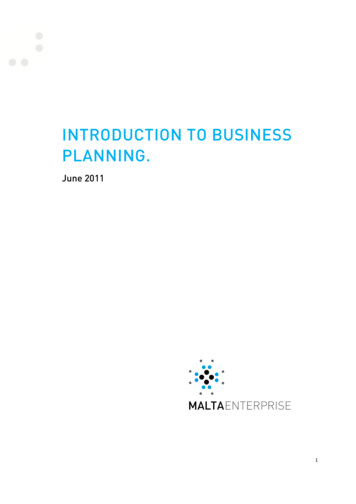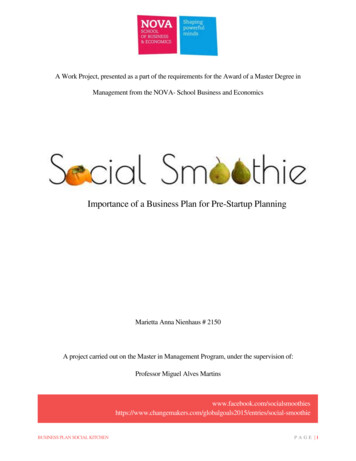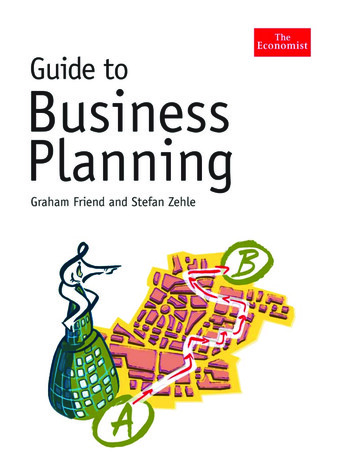
Transcription
GUIDE TO BUSINESS PLANNING
OTHER ECONOMIST BOOKSGuide to Analysing CompaniesGuide to Business ModellingGuide to Economic IndicatorsGuide to the European UnionGuide to Financial MarketsGuide to Management IdeasNumbers GuideStyle GuideDictionary of BusinessDictionary of EconomicsInternational Dictionary of FinanceBrands and BrandingBusiness EthicsBusiness StrategyChina’s StockmarketE-trendsGlobalisationSuccessful InnovationSuccessful MergersWall StreetEssential DirectorEssential EconomicsEssential FinanceEssential InternetEssential InvestmentEssential NegotiationPocket AsiaPocket Europe in FiguresPocket World in Figures
GUIDE TO BUSINESS PLANNINGGraham FriendandStefan Zehle
THE ECONOMIST IN ASSOCIATION WITHPROFILE BOOKS LTDPublished in 2004 by Profile Books Ltd3a Exmouth House, Pine Street, London ec1r 0jhCopyright The Economist Newspaper Ltd, 2004Text copyright Graham Friend and Stefan Zehle, 2004All rights reserved. Without limiting the rights under copyright reserved above, no part of this publicationmay be reproduced, stored in or introduced into a retrieval system, or transmitted, in any form or by anymeans (electronic, mechanical, photocopying, recording or otherwise), without the prior written permissionof both the copyright owner and the publisher of this book.The greatest care has been taken in compiling this book.However, no responsibility can be accepted by the publishers or compilersfor the accuracy of the information presented.Where opinion is expressed it is that of the authors and does not necessarily coincide with the editorialviews of The Economist Newspaper.Typeset in EcoType by MacGuru Ltdinfo@macguru.org.ukPrinted in Italy byLegoprint – S.p.a. – Lavis (TN)A CIP catalogue record for this book is availablefrom the British LibraryISBN-10 1 86197 474 4ISBN-13 978 1 86197 474 7
ctionThe business planThe business planning processStrategic planningAnalysing the environmentAnalysing the firmIndustry and competitor analysisProduct and portfolio analysisSWOT analysisGenerating strategic optionsMarket analysis and strategyMarket forecastingThe operational planModelling the businessAccounting principlesCompleting the financial statementsReviewing the financial statementsEvaluating strategic optionsFunding issuesRisk analysisPresenting the business plan and obtaining approvalImplementing the business 6241245AppendixIndex248263
This page intentionally left blank
11 IntroductionThis book is designed for those with an inspired idea who wish to translate it into asuccessful new business or incorporate it in an existing business. Usually, the first challengefor those who want to get a business idea off the ground is securing funding. Any investoror those in an existing business with responsibility for approving new initiatives willinvariably insist upon seeing a business plan before they approve any investment. Thebusiness plan, besides being a prerequisite for gaining access to finance, also provides theblueprint for successfully creating and running the new venture. This book describes abusiness planning process that will support the preparation of a compelling business planand the creation of a successful business.A business plan describes the business’s vision and objectives as well as the strategy andtactics that will be employed to achieve them. A plan may also provide the basis foroperational budgets, targets, procedures and management controls. No two businesses areidentical and no two business plans are ever exactly the same. This guide examines thedifferent reasons for preparing a business plan. It identifies who the potential audiences fora business plan are; how they read it; and what things different members of the audiencewill be looking for. The task of writing a business plan is a lot easier if you have a templatethat can be tailored to the specific needs of your business. Chapter 2 provides one. Alsoexplained is how to design and present a business plan to maximise the likelihood of itsgaining approval or funding.Although the presentation of the final business plan is important, ultimately the substanceof the plan is most crucial. The strategies and tactics described in the plan should be theoutputs from a logical and appropriately comprehensive business planning process. Themain emphasis of this guide is on the various stages of that process. This book provides apractical step-by-step business planning process and a reference for the tools andtechniques necessary to complete it. It begins with an overview of a typical business planand the remaining chapters correspond to the stages of the business planning processdescribed in Chart 1.1 on the next page.The process should begin by evaluating the business’s existing or intended position andthe environment in which it operates, before analysing existing or future customers,competitors and suppliers. The results of the analysis, combined with a set of expectationsabout the future, coupled with creative and innovative thinking, allow the business todevelop a range of strategic options designed to achieve its objectives. The evaluation stageincludes developing forecasts (notably for market demand), financial projections and, insome cases, a range of valuations, as well as calculating various measures of performance.The business planning process can also be used to test alternative ideas and assumptions,as one of the main reasons for planning is to help the business prepare for an uncertainfuture. Following stages include an examination of the funding issues and risk analysis,and lastly presenting and gaining approval for the business plan, and then implementing it.Because of the rapidly changing world in which businesses must operate, this guide placesconsiderable emphasis on business planning in the face of uncertainty and makes use oftechniques such as scenario planning.
21. INTRODUCTIONChart 1.1 The business planning processStrategic review and planStakeholder analysisVision, mission and objectivesEnvironmental analysisAnalysis of the firmChange strategy depending on outcome of evaluationChapters 4 to 10Industry and competitor analysisProduct and portfolio analysisSWOT analysisGeneration of strategic optionsMarketing planMarket analysis and strategyMarket forecastingOperational planModel the businessChapters 11 and 12Chapter 13Chapters 14 to 17Evaluate and select strategyChapter 18Examine funding issuesChapter 19Perform risk analysisChapter 20Present and approve the business planChapter 21Implement the business planChapter 22All business plans require some form of financial analysis and forecasts for the business orproject. Most financial projections are prepared in a spreadsheet package such asMicrosoft’s Excel. Chapter 14 describes the generic Excel spreadsheet business model thataccompanies this book and that can be used within your own business. The model alsoforms the basis for the detailed worked examples that are used to explain the basicprinciples of accounting and the preparation of financial statements in Chapters 15 and 16.
Using the book3This book is not, however, about business modelling, which is dealt with in The EconomistGuide to Business Modelling.USING THE BOOKAlthough this book provides a step-by-step guide to business planning, it can also bedipped into by those wanting to apply the techniques to address a specific businessappraisal or analytical challenge. Chart 1.2 on the next page provides a quick reference toall the business planning techniques used in the book, including the typical applicationsfor each technique and where they can be found.THE BUSINESS PLANNING MODELA business planning model built in Microsoft’s Excel is available for the readers of this book.To download the model visit www.guidetobusinessplanning.com and follow the simpledownload instructions. There are two versions available. The blank version (Blank Model) isdesigned to help the reader understand and apply the accounting techniques discussed inChapters 15–17. For experienced business modellers, this version can be customised to meetthe specific needs of their business. There is also a completed version (Complete Model),which represents the end result of working through the examples in the book. A full set ofoutputs from the completed model can be found in the Appendix.ACCOUNTING AND BUSINESS MODELLINGWhen considering the forecasting and accounting needs for your own business, you arestrongly recommended to gain professional assistance from trained accounting personnel ifthe accounting and modelling issues extend beyond those covered in this book. The banksfrom whom you hope to raise finance may be able to provide assistance with the creationof your financial projections or alternatively you can seek the help of a professionalaccounting firm or management consultancy. You may also be able to obtain help fromgovernment organisations established to support new business ventures. The specificdetails of setting up a new company or partnership are beyond the scope of this book, butChapter 13 provides a useful checklist of the issues that should be considered whencreating a new company. The first thing that you should think about, however, is whetheryou are emotionally prepared for the inevitable stress that running your own businessentails. We hope that this book will at least alleviate some of the pressures of preparingyour first business plan.
41. INTRODUCTIONChart 1.2 Quick reference guide to business planning g financial and operational data from competitors against which a business canmeasure its own performance. Helps to set targets and focus improvements on areaswhere this is most needed.Chapter 7, page 62Brand perception mapShows how a brand appeals to a differentiated set of needs. If segmentation is needsbased, the product should score highly against the targeted needs. Relevant fordeveloping the marketing strategy.Chapter 11, page 105Business/industryattractiveness screenA matrix commonly known as the GE Business/Industry Attractiveness Screen. It is usedto evaluate the position of a business or business unit.Chapter 8, page 81Business designThe process of establishing a business design incorporates elements of strategy andtactics. The business design describes the fundamental characteristics of the business,the most crucial of which is how the business establishes and maintains sustainablecompetitive advantage.Chapter 18, page 200Core competenciesThe functions or practices that are central to a business. The activity (or activities) thatthe business believes it does best. If a business’s core activity is closely aligned with itscore competencies it is better placed to achieve competitive advantage.Chapter 6, page 44Curve fittingA form of extrapolation used for market forecasting. It is based on the observation thattechnological and market developments usually follow an s-shaped pattern.Chapter 12, page 122Diffusion of innovationA model that describes how a new product or service is adopted by a population, mostcommonly known as the Bass model. Used for market forecasting.Chapter 12, page 125Directional policy matrixA technique derived from the growth-share matrix, but using a much wider range offactors to analyse a portfolio of products in terms of business sector prospects andbusiness position.Chapter 8, page 74Discounted cash flowOne of the most fundamental techniques for evaluating a business opportunity. Itexamines the amount, timing and risk associated with the cash flows of the business.An essential technique for evaluating strategic options.Chapter 18, page 209Economies of scaleEconomies of scale may occur when production volumes increase. Important in thecontext of cost leadership strategies and forecasting.Chapter 8, page 65Experience curveThe relationship between cumulative production volume and unit costs. Unit costs candecline in a predictable manner as the cumulative quantity produced over timeincreases. Useful for strategic planning and forecasting.Chapter 8, page 65, and Chapter 12, page 126
Quick reference guide to business planning techniques5Financial forecastingAll business plans require financial projections for the business’s profit and loss,balance sheet and, most crucially, its cash flow. Financial forecasting often involvespreparing a spreadsheet model.Chapter 14, page 144Generic strategiesPorter’s three generic strategies, cost leadership, differentiation and focus. The focusstrategy has two variants: cost focus and differentiation focus. Used to generatestrategic options.Chapter 10, page 90Growth-share matrixUsed to analyse a portfolio of products using market growth and market share. It hasstrategic implications, particularly for resource allocation in a multiple productbusiness.Chapter 8, page 69Industry life cycleA concept that describes the different growth stages of an industry.Chapter 7, page 55Key differentiators andunique selling pointsUnique attributes that differentiate a business from its rivals. A business shouldleverage the key differentiators in order to achieve competitive advantage.Chapter 6, page 42Key success factor rankingA method of analysing competitors against your own business, applicable to theanalysis of the firm as part of strategic planning.Chapter 7, page 61Market researchCollecting and analysing data from prospective customers to establish the likelydemand for a new product or service or to understand better customers’ preferences forexisting products.Chapter 12, page 111Market segmentationA market segment is defined as a sufficiently large group of buyers with a differentiatedset of needs and preferences that can be targeted with a differentiated marketing mix.To be of value, the benefits of segmentation must outweigh the costs. Useful fordeveloping the marketing strategy and for forecasting.Chapter 11, page 100, and Chapter 12, page 112Marketing mixA tool to position products in the target market. The marketing mix is defined by thefour Ps: product, price, promotion, place. All elements of the marketing mix togetherconstitute the “offer”. Relevant for developing the marketing plan.Chapter 11, page 103PEST analysisAn extremely useful technique for examining the environment in which the businessoperates. PEST is an acronym for the Political, Economic, Social and Technologicalinfluences on the business.Chapter 5, page 32Porter’s five forces modelProvides an analytical framework for the analysis of the structural factors that shapecompetition within an industry and from which a number of generic competitivestrategies can be derived.Chapter 7, page 57
61. INTRODUCTIONPortfolio analysisUses techniques such as the growth-share matrix to analyse a portfolio of products orstrategic business units to make decisions about their strategic direction and resourceallocation.Chapter 8, page 65Price elasticity of demandMeasures the sensitivity of demand growth of a product to the percentage drop in theunit price of the product. Used in market forecasting.Chapter 12, page 127Product life cycleA concept that describes the different stages of a product from introduction throughgrowth to maturity and decline. Has applications in market forecasting as well as instrategic and tactical planning.Chapter 8, page 66, and Chapter 12, page 124Product positioning mapA technique to map the position of a firm’s products and those of its rivals to the needsof the customer. Relevant for marketing strategy and planning.Chapter 11, page 104Project managementTechniques for managing efficiently the process of business planning. For a loneentrepreneur, issues of co-ordination do not arise and there is less need for detailedproject management. In larger organisations, where the business planning processinvolves a large number of people across a range of different departments, effectiveproject management of the process becomes essential.Chapter 3, page 23Ratio analysisCertain financial ratios can be calculated from the projected financial statements thatallow the liquidity, profitability and efficiency of the business to be evaluated. Ratioanalysis can be applied to evaluate strategic options.Chapter 17, page 187Regression analysisA statistical technique that examines the relationship between dependent variables,such as sales, and independent variables, such as price and commission. Thismethodology can be used for market forecasting as well as tactical decision-making.Chapter 12, page 119Resource auditIdentification of operational, human, organisational and financial resources coupledwith an analysis of efficiency and effectiveness of their utilisation. A business thatmakes optimum use of its resources may gain competitive advantage.Chapter 6, page 49Risk analysisFaced with an uncertain future, a business must examine the risks that it might face andthe tactics that can be used to mitigate them.Chapter 20, page 236Scenario planningA powerful technique for developing different views of the possible futureenvironments facing the business. It is often used in conjunction with PEST analysisand is useful for forecasting in uncertain markets.Chapter 5, page 36
Quick reference guide to business planning techniques7Strategic business unit(SBU)A division or department of a corporation that is sufficiently self-contained and couldoperate independently from the whole business. In larger organisations, strategicplanning can be carried out at the level of the SBU. The concept is applicable toportfolio strategies.Chapter 4, page 25SWOT analysisA simple and effective technique that analyses a business’s Strengths, Weaknesses,Opportunities and Threats.Chapter 9, page 85Time series methodA statistical analysis technique that examines how observed sequences of observationsevolve and develop over time. Often used in market forecasting.Chapter 12, page 114Value add analysisIdentifies how much value is created at different stages of the value chain. This enablesa firm to focus improvements or strategic change on areas where more value can beadded.Chapter 6, page 46Value chain analysisExplores the configuration and linkage of different activities that form a chain fromoriginal raw materials through processing, manufacturing, packaging, distribution,retailing and customer care to the end customer. It is used to optimise the allocation ofresources.Chapter 6, page 46Value systemExtends the value chain beyond the boundaries of the business and recognises that abusiness is dependent on relationships with suppliers and customers. It can be used tomake decisions about backward or forward integration to help position a business atthe most valuable parts of the value system.Chapter 6, page 49Vision, mission andobjectivesVision explains what the business intends to do. Mission explains how this vision is tobe turned into reality. Objectives provide a yardstick against which success can bemeasured.Chapter 4, page 27VRIO analysisA technique for analysing whether a resource is Valuable, Rare and Imitable andwhether the Organisation is taking advantage of the resource.Chapter 6, page 43
82. THE BUSINESS PLAN2 The business planBusiness decisions should always be made on the strength of the underlying business idea,but it is much easier to come to a decision if the idea is communicated simply and clearlyin a well-written business plan. The discipline required to articulate the business’s strategy,tactics and operations in a written document ensures rigorous analysis and greater clarityof thought. If the strategy of the business cannot be clearly and convincingly described onpaper, the chances of its working in practice are slim.No two businesses are ever identical and no two business plans are ever alike, but goodbusiness plans always contain a number of common themes. They “tell a story” andexplain how the business will achieve its objectives in a coherent, consistent and cohesivemanner. The “story” will be focused on the needs of the customer. The plan will identifythe market, its growth prospects, the target customers and the main competitors. It must bebased upon a credible set of assumptions and should identify the assumptions to whichthe success of the business is most sensitive. It should also identify the risks facing thebusiness, the potential downsides and the actions that will be taken to mitigate the risks.As the blueprint for the business, it should describe what makes the business differentfrom its competitors: its source of competitive advantage and how it will be sustained inthe longer term. It should describe the experience and track record of the managementteam, and, within larger organisations, the plan should have the support of those in thedifferent functions who will be involved in implementing it. Lastly, it should identify thefunding being sought from potential investors.A good business plan checklist: tells a coherent, consistent and cohesive, customer focused story;clearly defines the market, its prospects, the customers, suppliers and competitors;contains credible business planning assumptions and forecasts;describes how the business will achieve sustainable competitive advantage;identifies the assumptions to which the business is most sensitive, the potential risksand any mitigating actions; is supported by those that must implement it; contains a description of the individuals involved in managing the business; identifies the funding requirement for the business.What are they for?Before starting to write a business plan it is important to appreciate the reason forpreparing one. The focus and level of detail will vary depending on the decision thebusiness plan has been designed to support.Securing financeMost business plans are prepared in order to secure some form of funding. In the case ofnew business ideas, banks, venture capitalists and other providers of capital place greatemphasis on the business plan, as this is often all they have to rely upon. The business
The business plan9plan will generally focus on the growth prospects for the market and the sources ofsustainable competitive advantage for the business. The emphasis will be more on strategicand tactical considerations, as well as the financial projections, rather than on operationaldetail.Operational management and budgetingThe business plan can also provide the basis for the creation of business processes, jobdescriptions and operational budgets. It can also provide the basis for monitoring andanalysing performance. In this instance, the business plan will say little about strategic andtactical considerations and will focus on technical details, process descriptions and productspecifications.Other usesTo get approval or finance for a project and to help manage it are the common reasons forproducing a business plan. However, the process of preparing one can be used as amechanism for reconciling conflicting views and building consensus, as well ascommunicating the vision, mission and goals of larger companies.Business plans may also be prepared as part of a tender process for the right to operateassets or services that are allocated by a government body. The tender process issometimes referred to as a “beauty parade” as the companies must prepare a business planthat displays their technical, operational and business skills in the best light. A beautyparade might be used for the allocation of radio spectrum, or the right to administer anational lottery or operate rail services.Who are they for?In the same way that no two businesses are alike, no two readers will be looking forexactly the same issues or messages in the business plan. Indeed, the different needs ofdifferent audiences can be such that it may be necessary to create more than one versionof the same plan.Bankers and others providing debt financingWhen lenders review a business plan they are concerned with three main issues: If the loan is only one element of the financing necessary to fund the business planfully, are the other sources of finance in place and secure? Will sufficient cash be generated by the business to meet interest payments on theloan and to repay the principal? Are there physical assets, or other forms of collateral, within the business againstwhich a loan can be secured so that, were the business to fail, the lender would beable to get all or some of its money back?Bankers will look closely at the financial forecasts contained within the business and the
102. THE BUSINESS PLANunderlying assumptions on which those forecasts rely. They will wish to satisfy themselvesthat they are credible. As part of their financial analysis of the business plan they will lookclosely at the balance sheet to assess its strength and the liquidity of the business. Theywill examine the gearing, the ratio of debt to equity within the business, to ensure that thebusiness does not become too heavily geared towards debt, which will increase thepossibility of default on the loan. They may also examine ratios such as interest coverwhich is described in more detail in Chapter 17.Providers of equity fundingThere are many organisations and individuals who might provide equity funding tosupport a business plan. Family and friends are often the first port of call for smallerbusiness ventures. The providers of more substantial levels of equity or share capital fornew business ventures include venture capitalists and private equity houses, who have ashorter investment time horizon compared with, say, institutional investors. Pension fundsand other institutional investors may already be investors in an existing business and willbe among the first to be approached when additional capital is required. Another source ofequity funding may be a business considering some form of merger or partnership, whichit may achieve through an equity injection into the business. The appropriate sources offunding for different business plans are discussed in detail in Chapter 19. As providers ofequity finance or share capital are last in the line of creditors to be paid when a firm goesbust, their concerns are different from those of bankers: Is the business proposition a strong one and is there an identifiable source of sustainable competitive advantage that will allow the business to outperform themarket in the long term?What is the expected return on equity (roe – see Chapter 17)?How experienced and capable is the management team?Is the business plan fully funded and what are the risks that more equity capital willbe needed, leading to a dilution of the equity stakes of those who invest first?What are the growth prospects for the business and the potential for capitalappreciation and/or a strong dividend stream?What returns have been achieved on any previous equity injections into thebusiness?How will the providers of equity be able to exit from the business and realise thegain on their investment?The providers of equity will look closely at the credibility of the financial statements andthe level of gearing (the ratio of debt to equity within the balance sheet). The more highlygeared the business, the greater is the level of financial risk faced by the equity providers.These themes are explored in more detail in Chapter 20.The management team of a large, existing businessIt is usual for business units in large organisations to prepare business plans in order togain approval (and resources) for new business initiatives from senior management andthe board. The issues that they will wish to see addressed vary from organisation toorganisation and according to the strategic, tactical or financial challenges facing thebusiness at the time. However, it is possible to say that they will wish to be presented with
A business plan template11a business plan that is consistent with their stated objectives, strategic imperatives andfinancial constraints. The following list gives an indication of the questions they are likelyto ask: Is the plan consistent and supportive of the business’s overall strategy? What is the likely impact on the overall financial performance of the business in terms of revenue growth, profitability and gearing?Will adopting the business plan require the raising of additional financing?Does the business plan reinforce the position of the business’s brand?Is the business plan feasible and within the scope of the organisation’s capabilities?How will the press and the financial markets react to the adoption of the businessplan?Will the adoption of this business plan have an impact on other areas of thebusiness?What alternative opportunities could be pursued?The list of potential questions is endless and those responsible for writing the businessplan need to anticipate and address the issues that will be of most concern to those whomake the final decision on whether to go ahead with the project or not.A BUSINESS PLAN TEMPLATEThe style, length and content of a business plan will depend on the business decision oractivities the plan is designed to support and the audience for whom the plan is to beprepared. There are no hard and fast rules as to length, but a business plan should be asshort as possible while meeting all the needs of those who will read it. During the heydayof the dotcom boom, business plans were occasionally presented as “elevator pitches”:those with a business idea had as long as an elevator journey to convey the main thrust oftheir business plan. These days, as in pre-dotcom days, business plans are expected to bemore substantial. A business plan for a small and straightforward business may range from20 to 40 pages, whereas a “beauty-parade” document may run to over 500 pages once allthe technical appendices have been included. In large organisations the format for businessplans may be predefined, and in the case of tenders or beauty parades a structure may beprovided as part
All business plans require some form of financial analysis and forecasts for the business or project. Most financial projections are prepared in a spreadsheet package such as Microsoft’s Excel. Chapter 14 describes the generic Excel spreadsheet business model that accompanies this book and that can be used

